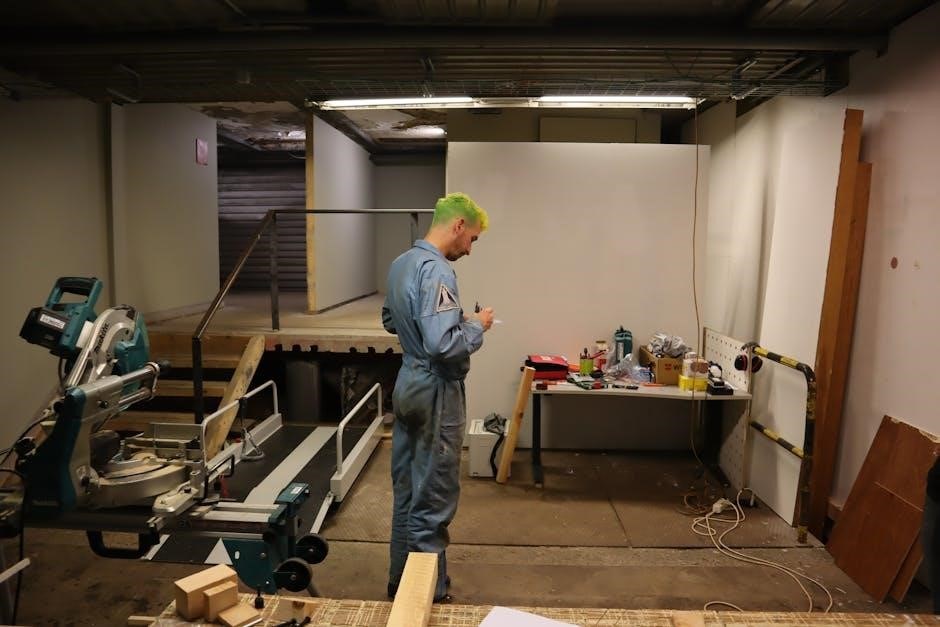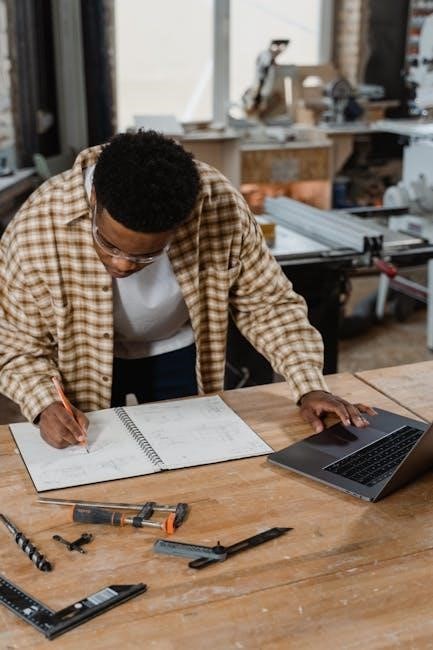table saw station plans pdf
Summary
Get instant access to table saw station plans in PDF format. Easy to build with step-by-step guides, perfect for woodworking projects.

Table saw station plans offer a versatile way to enhance woodworking projects, improving efficiency and allowing customization to fit various workshop needs and preferences.
Overview of Table Saw Stations
A table saw station is a customizable workstation designed to house a table saw, enhancing its functionality and versatility in woodworking projects. These stations often include features like storage, dust collection, and additional work surfaces, making them ideal for both hobbyists and professionals. They can be mobile or stationary, catering to different workshop layouts and preferences. Many designs incorporate space-saving ideas, such as folding wings or ergonomic layouts, to optimize efficiency. Table saw stations also provide a stable and secure platform for the saw, improving accuracy and safety during cuts. With various plans available, users can choose or modify designs to suit their specific needs, ensuring the station adapts to their workflow and workspace constraints.
Importance of Proper Planning and Design
Proper planning and design are crucial when building a table saw station to ensure functionality, safety, and durability. A well-thought-out design maximizes workspace efficiency, allowing easy access to tools and materials. It also ensures the station is tailored to the user’s specific needs, whether for professional or hobby projects. Correct measurements and material selection prevent structural issues and enhance performance. Additionally, considering ergonomics in the design reduces fatigue and improves comfort during long work sessions. Planning also helps incorporate essential features like storage and dust collection, which are vital for maintaining a clean and organized workshop. Without proper planning, the station may become impractical or even unsafe, highlighting the importance of careful design before construction begins.
Safety Considerations for Table Saw Workstations
Safety is paramount when designing and using a table saw workstation. Proper installation of safety features like splitters and blade guards prevents kickbacks and accidental injuries. Ensuring the fence is secure and aligned reduces the risk of uneven cuts and material movement. Adequate lighting and a clear workspace improve visibility, minimizing accidents. Regular maintenance, such as checking blade sharpness and ensuring the table is level, is essential for safe operation. Incorporating emergency stop mechanisms and keeping loose clothing tied back further enhances safety. A well-designed workstation with built-in safety measures not only protects the user but also ensures precise and consistent cutting results. Always follow manufacturer guidelines and woodworking safety practices to maintain a secure working environment.

Materials and Tools Required

Essential materials include 2×4 lumber, 3/4-inch plywood, and galvanized screws. Tools needed are a drill press, impact driver, circular saw, and sandpaper for smooth assembly and finishing.
Essential Lumber and Hardware
The foundation of a sturdy table saw station begins with high-quality lumber and hardware. Typically, 2×4 lumber is used for the frame and legs, ensuring stability and durability. For the table top, 3/4-inch plywood or MDF is ideal due to its smooth surface and resistance to warping. Additional materials like 2×2 lumber can be used for supports or shelves. Hardware such as galvanized screws, bolts, and brackets are essential for securing the structure. Wood glue and clamps are also necessary for tight joints. Proper hardware ensures the table saw remains aligned and stable during use. Pre-drilling holes for screws can prevent splitting the wood. Choosing the right materials guarantees a professional-grade workstation tailored to your needs.
Power Tools and Accessories Needed
Building a table saw station requires a range of power tools and accessories to ensure precision and efficiency. A table saw is the centerpiece, but additional tools like a drill press, router, and sander may be necessary for advanced features. Essential accessories include high-quality drill bits, saw blades, and sanding belts. A reliable dust collection system is crucial for maintaining a clean workspace and improving safety. Clamps and vises are indispensable for holding materials securely during cuts. Measuring tools, such as tape measures and squares, ensure accuracy in construction. Optional accessories like a miter gauge or fence system can enhance functionality. Having the right tools and accessories on hand streamlines the building process and ensures a professional-grade finish.
Optional Features for Enhanced Functionality
Optional features can significantly enhance the functionality of your table saw station, catering to specific needs and preferences. Incorporating a router table allows for versatile woodworking operations, while a dust collection system improves workspace cleanliness and safety. An outfeed table provides additional support for large materials, reducing strain and ensuring precise cuts. Folding wings or extensions can maximize space in smaller workshops. Adding storage compartments or shelves keeps tools and accessories organized and within reach. Mobility features, such as casters, enable easy repositioning of the station. Customizable fences or miter gauges can enhance accuracy, and optional lighting or electrical outlets add convenience. These features allow you to tailor your table saw station to your workflow, making it a highly functional and adaptable workspace.

Designing Your Table Saw Station
Designing a table saw station involves planning for space efficiency, ergonomic comfort, and adaptability to your woodworking needs, ensuring a functional and adaptable workspace.
Space-Saving Layout Ideas
Maximizing workshop space is crucial, especially in smaller areas. A well-designed table saw station can incorporate foldable wings, collapsible outfeed tables, and vertical storage solutions to save floor space. Mobile bases with locking casters allow easy repositioning, enabling efficient workflow without sacrificing stability. Compact designs often feature integrated shelves or drawers for tools and accessories, keeping essentials within reach while maintaining a clutter-free environment. Additionally, consider a hybrid workstation that combines a table saw with a router table or miter saw stand, reducing the need for separate units. These space-saving ideas ensure optimal functionality even in limited workshop spaces, making every inch count for woodworking projects.
Ergonomic Considerations for Comfort

Ergonomic design is essential for a comfortable and efficient table saw workstation. Ensure the table height aligns with your stature to prevent back and neck strain during long projects. Incorporate features like angled fences or adjustable supports to maintain natural posture. Foldable wings or extensions can provide additional workspace without compromising ergonomics. Storage compartments should be placed within easy reach to minimize bending or stretching. Consider adding a non-slip surface or ergonomic handles for better grip and control. A well-organized layout reduces fatigue and enhances focus, making your woodworking experience safer and more enjoyable. By prioritizing comfort, you can work for hours without discomfort, ensuring precision and productivity in every cut.
Mobile vs. Stationary Designs
Choosing between mobile and stationary table saw designs depends on your workshop needs. Mobile designs offer flexibility and space efficiency, ideal for smaller workshops. They include casters for easy movement and

Step-by-Step Construction Guide
A comprehensive guide providing detailed instructions for building a table saw station, including essential tools and materials for a stable, functional, and expandable workstation.
Building the Base and Frame
Constructing a sturdy base and frame is crucial for stability. Use durable materials like 2×4 lumber for the base, ensuring it’s level and secure. Attach the frame to the base using bolts, providing a solid foundation for the table saw. A reinforced structure prevents vibration and ensures precise cuts. Consider adding casters for mobility, allowing easy repositioning in your workshop. Proper alignment and tight joints are essential to avoid any wobbling. Sand and finish the frame to protect it from moisture and wear. This step ensures your table saw station is both functional and long-lasting, ready for various woodworking tasks.
Constructing the Table Top and Wings
Constructing the table top and wings requires precise measurements and durable materials. Use high-quality plywood or MDF for a smooth, even surface. Attach the wings using hinges for easy folding and storage. Ensure the table top aligns perfectly with the saw blade for accurate cuts. Sand the surface to prevent splinters and apply a protective finish. For added functionality, consider an extension wing to support larger materials. Proper alignment and secure fastening are critical for stability. Optional features like a router table integration can enhance versatility. Ensure all joints are tight and reinforce with brackets if necessary. Safety features, such as emergency stops or splash guards, can be incorporated. This step ensures your workstation is both functional and safe, ready for various woodworking tasks.
Installing the Fence System
Installing the fence system is crucial for accuracy in cuts. Use a rigid material like steel or aluminum for durability and straightness. Attach the fence to the table using brackets or clamps, ensuring it aligns perfectly with the saw blade. Secure the fence tightly to prevent any movement during operation. For added precision, consider a micro-adjust feature to fine-tune the fence position. Ensure the fence is parallel to the blade and level with the table surface. Proper installation enhances cutting accuracy and improves safety by reducing the risk of kickback. Optional features like a flip-up fence or adjustable stops can further customize the system. A well-installed fence system is essential for achieving professional-grade results in woodworking projects.
Adding Storage and Shelving

Adding storage and shelving to your table saw station is essential for maintaining an organized and efficient workspace. Begin by planning the placement of shelves or cabinets, ensuring they do not obstruct the operation of the saw or fence system. Utilize materials like plywood and 2x4s to construct shelves, considering the addition of drawers for small tools if possible. Ensure shelves are sturdy and can hold the weight of tools and materials. Consider the height and accessibility of storage solutions, opting for adjustable shelves to customize storage needs over time. For added convenience, incorporate casters to create mobile storage units that complement the table saw station. Finally, protect shelves with a durable finish to prevent dust accumulation and ensure longevity. Keep the design simple initially, focusing on functionality and ease of use.

Additional Features for Functionality
Enhance your table saw station with practical features like dust collection systems, outfeed tables, and router table integration for improved precision and workflow efficiency, ensuring optimal workspace utilization and versatility.

Incorporating a Router Table
Incorporating a router table into your table saw station enhances functionality, allowing for versatile woodworking operations like edge routing, dado cuts, and dovetail joints. Many modern designs include this feature, as it streamlines workflows and saves space. When planning, consider the router table’s placement adjacent to the saw for easy access. Ensure the table’s size aligns with your router’s dimensions for seamless integration. A removable insert plate is also beneficial for accommodating different router bits. Optional enhancements, such as a router lift or storage for bits, can further optimize the setup. Step-by-step plans often provide detailed instructions for this addition, making it accessible for DIY enthusiasts. This integration transforms your workstation into a multi-functional hub, boosting productivity and creativity in your projects.
Adding Dust Collection Systems
Adding a dust collection system to your table saw station is essential for maintaining a clean and safe workspace. These systems efficiently capture sawdust and debris, reducing airborne particles and improving visibility. When designing your station, consider integrating a dust port that aligns with your table saw’s dust collection outlet. A vacuum or central dust collection unit can be connected to this port, ensuring efficient cleanup. Many plans include detailed instructions for installing ductwork or hoses, while others suggest using portable vacuum systems. Proper installation ensures optimal performance, preventing clogs and maximizing suction power. Additionally, some designs incorporate dust collection drawers or bins for easy disposal. This feature not only enhances workshop cleanliness but also prolongs tool life by minimizing dust exposure. Step-by-step guides often provide tips for customizing the system to your specific setup.

Outfeed Table and Support Options
An outfeed table is essential for supporting large materials as they exit the saw, ensuring precise cuts and preventing warping or damage. Fixed tables offer stability and durability, ideal for frequent use, while folding designs provide space-saving convenience, perfect for smaller workshops. Additional support options like auxiliary rollers or extensions can be incorporated to handle extra-long workpieces. For enhanced flexibility, consider adding caster wheels, allowing easy repositioning of the outfeed table to suit different project needs. These features collectively optimize workflow, reduce material damage, and enhance overall workshop efficiency; Properly integrating these elements into your table saw station ensures a smoother, more professional cutting experience.
Final Touches and Maintenance
Apply a protective finish to the surface for durability and easy cleaning. Regularly inspect and maintain all moving parts to ensure optimal performance and longevity of your station.
Finishing and Protecting the Surface
Finishing and protecting the surface of your table saw station is essential for durability and ease of maintenance. Apply a water-resistant finish, such as polyurethane or wax, to shield the wood from spills and dust; Regularly clean the surface with a soft cloth and avoid using harsh chemicals that could damage the finish. For added protection, consider applying a food-safe oil to the table top to prevent warping and cracking. Always allow the finish to dry completely before using the station. Proper maintenance ensures the surface remains smooth and functional, extending the lifespan of your workstation. Touch-ups may be needed over time to address wear and tear, especially in high-use areas.
Regular Maintenance Tips
Regular maintenance is crucial to keep your table saw station operating smoothly and safely. Check the fence alignment frequently to ensure accurate cuts and adjust it as needed. Lubricate moving parts, such as the saw blade and fence mechanisms, to prevent rust and friction. Inspect the table top for any damage or unevenness and address issues promptly. Dust collection systems should be cleaned regularly to maintain airflow efficiency. Additionally, tighten any loose bolts or screws to ensure stability and prevent vibration. Store the station in a dry, clean environment to protect it from moisture and pests. By following these maintenance tips, you can extend the lifespan of your table saw station and maintain peak performance for consistent results.
Building a table saw station is a rewarding project that enhances workshop efficiency and versatility. With proper planning and execution, your custom station will serve as a reliable workhorse for years. Consider future upgrades like adding a router table or dust collection system to expand functionality. Exploring new materials or designs can further personalize your setup. Regular maintenance ensures optimal performance, while creative modifications can address evolving project needs. Whether you’re a hobbyist or a professional, a well-designed table saw station is an invaluable asset. Embrace the flexibility of DIY upgrades to keep your workspace adaptable and efficient, ensuring it remains a cornerstone of your woodworking endeavors.